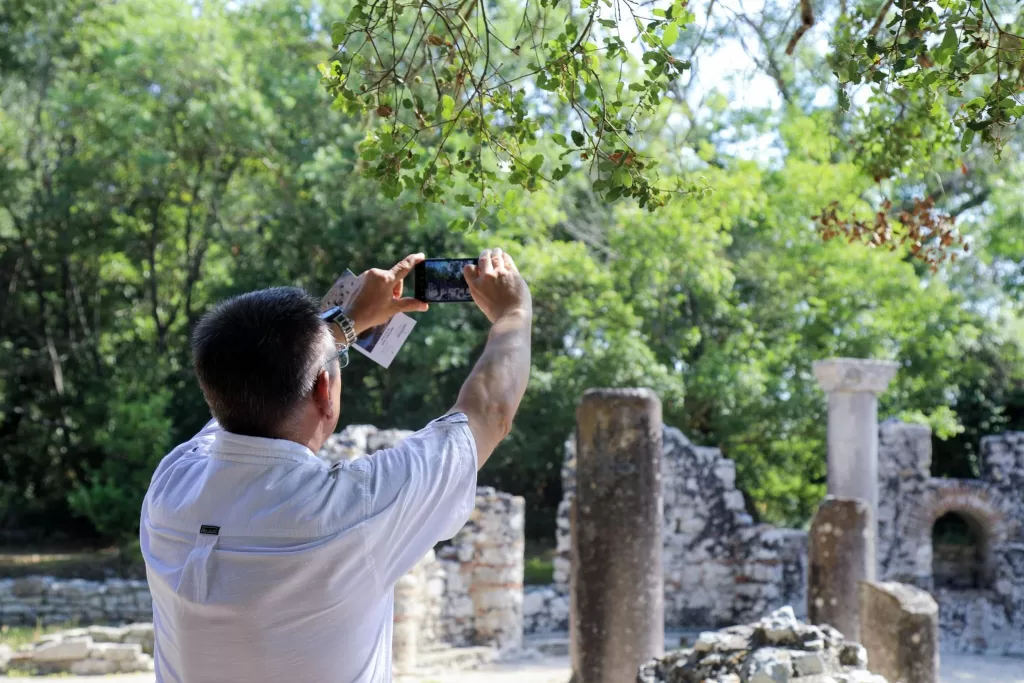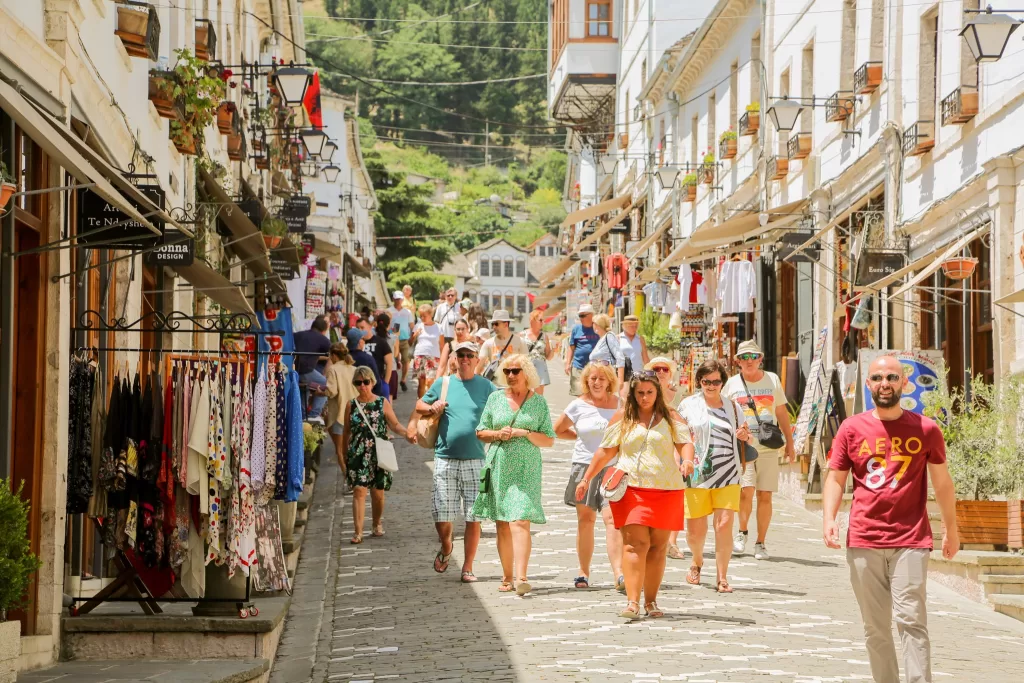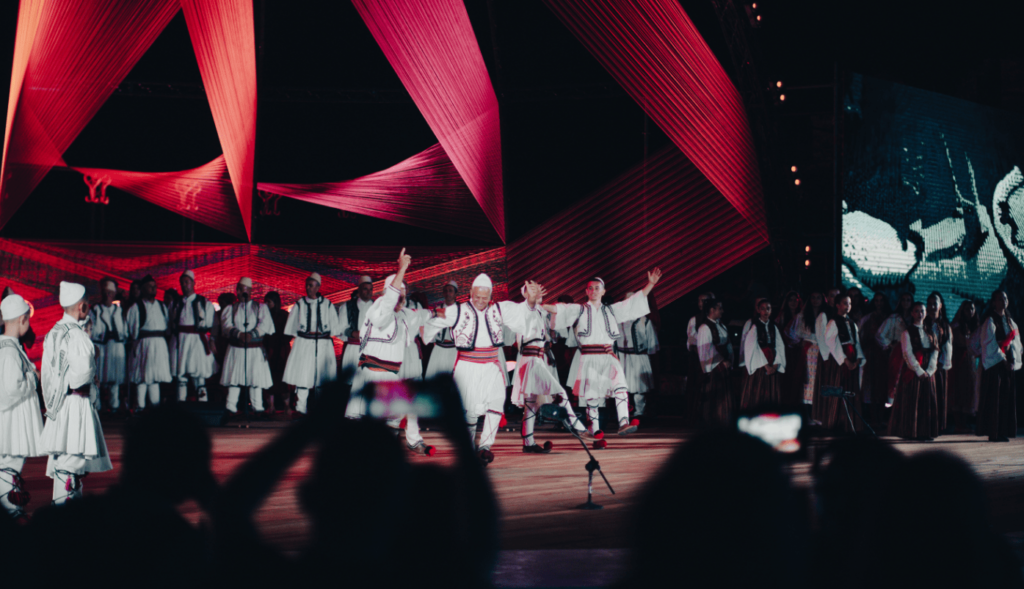Butrint, the Microcosm of the Mediterranean, a UNESCO property

The ancient city of Butrint, located in southern Albania, is an oasis of rich cultural history and Mediterranean biodiversity, a priceless treasure of UNESCO-protected Cultural Heritage. It is a place where human history’s monuments and the natural environment beautifully intertwine.
Butrint National Park encompasses a variety of natural beauties and values, including Mediterranean forests and maquis, cultivated fields, terraces with fruit trees, coastal waters with sandy and rocky shores, open lands, and habitats that shelter a significant diversity of nationally and globally important flora and fauna. This makes Butrint one of the most important areas for biodiversity in Albania.
The ancient city of Butrint was first declared a Cultural Monument in 1948. In 1999, it was registered on the UNESCO World Heritage list; in 2003, the wetland complex, including the Butrint lagoon and coastal area up to Cape Stillo, was declared a Ramsar Site and a National Park (Category II of IUCN’s Protected Area Management Category). Due to its importance in preserving cultural and archaeological heritage, Butrint became part of the UNESCO World Heritage list, and this protected area covers 2900 hectares, including culturally significant landscapes and archaeological remains.
In the park, besides the known Mediterranean species, there are 16 endangered species of flora and 14 endangered species of fauna. Lake Butrint, surrounded by forested shores, mountains, water, and salt marshes, is connected to the Corfu Strait by the Vivari Channel.
The archaeological remains are part of the natural forest with a complex ecosystem, depending on the waters near Lake Butrint and the Vivari Channel that drains the lake into the Ionian Sea.
Butrint is a microcosm of Mediterranean history, presenting over 2000 years of history from Hellenic temples of the 4th century BC to Ottoman castles of the early 19th century.
According to classical mythology scholars, Buthrotum was built by migrants fleeing after the fall of Troy. The mythology tells that upon arrival, Priam’s son, Helenus, sacrificed a bull, which staggered wounded and died on the shore. The place was named Buthrotum, meaning “wounded bull.” Later, Virgil’s epic poem, the Aeneid, recounts Aeneas’s visit to Butrint during his journey to Italy, a time when the city was fortified with a large wall with five gates.
During Julius Caesar’s rule, a colony was established there, and Roman veterans were settled. Emperor Augustus doubled the city’s area, with new buildings including Roman baths, several houses, a forum, and a nymphaeum.
In the 3rd century AD, a significant part of the city was destroyed by an earthquake, which led to Butrint’s uninterrupted decline. In the early 6th century, Buthrotum became a bishopric with new constructions, including a large baptistery (one of the largest paleo-Christian buildings of its kind) and a basilica.
Butrint was governed by the Byzantines and was a strategic point on the Adriatic-Ionian maritime routes, contested by Venetians and Ottomans, until Albania declared its Independence in 1912.
Customise your Albanian tour now!
Other Destinations
The enchanting Gjirokastra and the unique hospitality of the stone town

Gjirokastra, known as the “city of a thousand steps” and renowned for its unique charm and hospitality, is a UNESCO World Heritage site located in the southern part of Albania. This city is characterized by hundreds of Ottoman-style tower houses with stone roofs, wooden balconies, and stone walls, sometimes whitewashed with lime. The majestic castle perched on a steep hill adds to Gjirokastra’s enchanting atmosphere. This city, with its tumultuous past, has been part of the UNESCO World Heritage list since 2005.
Gjirokastra’s architectural values are evident in its stone-built houses, stone-slated roofs, and cobblestone streets, particularly in the mysterious alleys of Qafa e Pazarit. These features have been transformed into invaluable tourist and cultural assets that have been attracting international visitors for many years.
The city’s origin lies in Argjiro, a castle built in the 4th century AD, which is the city’s most significant structure and the largest in Albania. The city was named Argyrokastro in 1336 and reached its peak during 1800-1830 when the characteristic monumental houses of the Ottoman period were built.
Gjirokastra showcases the Ottoman tradition in construction, evident even today. Unlike many Western European cities built on river plains, Gjirokastra was constructed on a hillside to preserve agricultural land. Its main components include the castle, which served as the ruler’s palace and a military fortification; the bazaar for crafts and trade; religious buildings (churches, mosques, and tekkes); residential neighborhoods; and fortified monumental houses.
Gjirokastra lacked urban squares for public gatherings and a municipality for citizen representation, as the castle was the sole embodiment of order and administration, and the only social spaces were religious complexes.
Built by large landowners, the city features houses with bay windows, typical of the Balkan region. Gjirokastra contains remarkable examples of these houses dating from the 17th century and more elaborate examples from the early 19th century.
Gjirokastra is exceptionally valuable for its unique use of stone in building houses that resemble small castles, cobblestone alleys, all leading to the bazaar. It stands as an extraordinary testament to the diversity of urban societies in the Balkans and a unique way of life that is almost extinct.
When visiting UNESCO’s Gjirokastra, don’t miss the chance to try the unique local dishes like pasha qofte, shapkat, and especially oshaf with dried figs, a dessert made with sheep’s milk that delights every Mediterranean cuisine enthusiast.
Gashi River, UNESCO’s fairytale reserve

The Gashi River in Albania is one of the two Albanian natural reserves included in UNESCO’s World Natural Heritage list. Spanning 3,000 hectares, the Gashi Valley is located in the basin of the Valbona National Park, northeast of the Albanian Alps, in the Tropojë District, far from populated areas.
A significant part of the Gashi River area is covered with virgin beech forests, and these ancient woods are the reason Albania joined 12 other countries on the UNESCO list..
Near the Gashi River are the glacial lakes of Dobërdol and Sylbicë, which bestow the entire area with a fairy-tale appearance. This Albanian river sings a sweet song of untouched nature and offers a tranquil haven for those seeking to immerse themselves in its natural beauty.
This natural wonder preserves one of the most pristine natures in Albania, continually attracting and fascinating observers!!
Albanian iso-polyphony, a masterpiece of world heritage

Albanian Iso-polyphony, recognized as a “Masterpiece of the Oral and Intangible Heritage of Humanity” by UNESCO, was included in UNESCO’s World Heritage list on November 25, 2005.
Albanian Iso-polyphony is considered by folklore researchers as one of the masterpieces of Albanian musical folklore and of global folkloric tradition in general. The structure of the polyphonic two-part, Lab or Tosk style, is a direct expression of the genetic unity of the genre.
Two-voice Iso-polyphony, considered the simplest form of Albanian polyphony, is widespread throughout southern Albania. This two-voice style (lead and drone) is found in both women’s and men’s singing. Its geographical spread encompasses virtually the entire geographical area of Toskëri and Labëri, including the districts of Korçë, Librazhd, Pogradec, Kolonjë, Fier, the upper part of Elbasan’s Shpat, the coastal Myzeqe, Vlora’s Myzeqe, the city of Vlora, the Vlora river area, villages of Berat, Mallakastër, Gjirokastër-city, Lunxhëri, etc.
This two-voice style is also found among the Arbëreshë of Calabria, where it enjoys widespread and continued use to this day.
Three-voice Iso-polyphony predominates in the popular iso-polyphonic repertoire of the villages in Southern Albania, also known as vocal iso-polyphony and the urban version accompanied by saze (traditional instruments). This is the basic form of our polyphony, where the voices are individualized not only melodically but also have meaningful designations for the roles they perform. Three-voice Iso-polyphony is predominantly sung by men.
This original form of our polyphony has also been inherited in the urban popular music of Southern Albania, known as iso-polyphonic music with saze. Albanian iso-polyphony is characterized by songs composed of two solo parts, a melody and a counter-melody with a choral drone. The structure of the solo parts varies according to the different ways of interpreting the drone, which has a wide variety of structures, especially in the popular style adapted by all groups performing this music.
Prof. Dr. Vasil S. Tole writes that “unlike the Lab song mass, which is more vertical than horizontal, the polyphonic song of the city of Gjirokastër develops and exhibits the most horizontal iso-polyphony in all of Labëria. Apparently, the refinement of the rural song around Gjirokastër, from which the urban Gjirokastra song originates, came along with the growth and development of the Gjirokastra resident himself. Uniquely and unlike any other city, the urban popular music of Gjirokastër did not accept the introduction of musical instruments (sazes), as happened in 99% of southern Albanian cities, but refined the polyphonic song of the tradition, which it continues even today.”
Iso-polyphonic music accompanies a wide range of social events, such as weddings, funerals, local festivals, religious celebrations, and national festivals like the renowned National Folkloric Festival in Gjirokastër.
In recent decades, the growth of cultural tourism and the increasing interest of the scholarly community in this unique folk tradition have contributed to the revival of Albanian iso-polyphony.
Customise your Albanian tour now!
Other Destinations
Get in touch with our friendly team
- contact@absolutealbania.com
- +355 67 40 567 56
